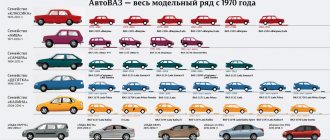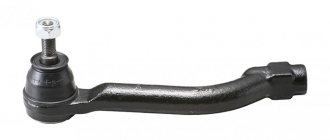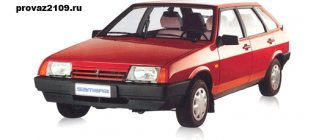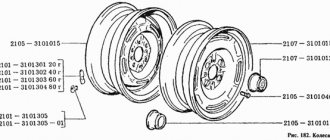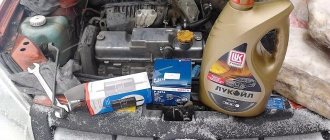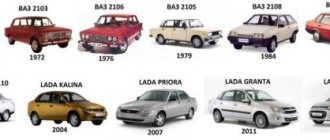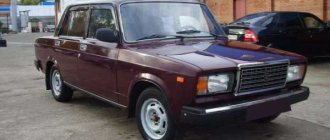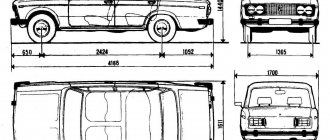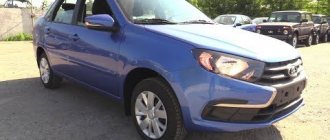Production of the legendary seven at the Volzhsky Automobile Plant began in March 1982 and continued for more than 30 years. The car still enjoys well-deserved popularity in our country and abroad. The dimensions of the car allow it to be classified as class B according to the international standard or group 2 according to the national standard. VAZ 2107 is currently being assembled at Izhmash and in the Chechen Republic.
The Seven was exported under the name Lada 1500, Riva or Nova. It is an improved luxury version of the 2105 model. A number of changes were made to the design of the prototype, in particular the electrical circuit, attachments and the engine itself were changed. The VAZ 2107 has an improved interior; the front row has seats with integrated headrests.
Geometric parameters of the car
The car has a monocoque three-volume sedan-type body in the classic version. The engine compartment is located in the front part, the closed passenger compartment is in the middle, and the trunk is located at the rear. There are 4 doors for the driver and passengers to enter; the engine compartment is closed by a hood that rises forward. This scheme has become most widespread in the automotive industry as the most successful.
The table of dimensions of the VAZ 2107 car is given in the technical documentation; the main parameters are:
| total length at the extreme points of the bumpers | 4145 mm |
| greatest width: along the door shirts | 1620 mm |
| greatest width: according to rear view mirrors | 1740 mm |
| base - the distance between the wheel axles | 2424 mm |
| vehicle height without antenna | 1446 mm |
| ground clearance | 120 mm |
| for vehicles equipped with a neutralizer | 90 mm |
| distance between the center lines of the wheels in front | 1365 mm |
| rear wheel center distance | rear 1321 mm |
A detailed diagram with precise indication of linear dimensions is indicated in the official publication of the vehicle operating instructions.
General view
ATTENTION! A completely simple way to reduce fuel consumption has been found! Don't believe me? An auto mechanic with 15 years of experience also didn’t believe it until he tried it. And now he saves 35,000 rubles a year on gasoline! Read more". The exterior of the “Seven” generally copies other VAZ models, called “classics”
On the other hand, some parts and components of the frame are not the same. They simply will not fit the general exterior due to the fact that they differ in basic parameters
The exterior of the “Seven” generally copies other VAZ models, called “classics”. On the other hand, some parts and components of the frame are not the same. They simply will not fit the general exterior due to the fact that they differ in basic parameters.
Let's start with the front. This area of the car includes these components: the hood, the apron with the front bumper (they are considered more decorative elements) and the fenders.
As for the middle part of the car, this includes the roof of the VAZ 2107, sills, and doors.
Finally, the rear of the car includes the fenders, boot lid and rear apron.
All main body elements are made of stamped steel, additional ones are made of plastic. If minor damage occurs, they can be easily straightened and, if necessary, replaced with new ones without much difficulty.
Comparatively, the “seven” looks more modern than other “classic” models. It is for this reason that the car remained on the production line, although the designers did not make any significant changes.
The car interior is equipped with 4 seats. The front seats are made in the form of an independent adjustable design. As for the rear ones, they have no adjustment. The interior lining is plastic, the roof is covered with leatherette.
The interior of the “Seven” is structurally excellently protected from frontal and rear impacts, but a side collision with another car can lead to catastrophic consequences.
Machine weight characteristics
For its time, the VAZ 2107 was an excellent car that was successfully sold, including outside our country. The machine's technical characteristics were not inferior to its analogues at a lower price; the design scheme used is highly reliable. The weight of the equipped vehicle is just over a ton, which allows it to demonstrate good power capacity.
The maximum permissible load is 400 kg, in other words the car can carry five adult passengers. If the quantity is smaller, luggage can be transported in a special compartment. A rational distribution of masses between the axles ensures good stability and controllability of the vehicle.
The small dimensions of the VAZ 2107 model, optimal weight for its size and a powerful engine provide the car with good dynamics and maneuverability. The successful design and low price predetermined the car's commercial success and, despite its advanced age, it still does not lose popularity.
VAZ 2107 is a rear-wheel drive car of group II of the small class of the AvtoVAZ company, produced from 1982 to 2012.
Body dimensions of VAZ 2107:
- VAZ 2107 2107 1.5 MT (72 hp): 4145x1620x1440 (mm).
- VAZ 2107 2107-20 1.5 MT (68 hp): 4145x1620x1440 (mm).
Dimensions are given in length/width/height format.
Additional sizes:
Modification track size:
Note:
- VAZ 2107 body type: sedan (4 doors, 5 seats).
- Standard clearance size: 170 (mm).
Important: the wheelbase size of the VAZ 2107 modifications is 2424 (mm).
Other names:
The 4-door VAZ 2107 sedan was exported under the names Lada Nova, VAZ 2103, VAZ 1500, Lada Riva, Lada Signet, Lada 1500.
Years of production years of production of all modifications of the model: 1982-2014.
| VAZ 2107 1982 - detailed dimensions |
| VAZ 2107 1990 - detailed dimensions |
| VAZ 2107 bodies - detailed dimensions |
| VAZ 2107 cylinders - detailed dimensions |
| General parameters of VAZ 2107 bodies | |||
| General view General view of bodies | Length min (mm) Minimum overall vehicle length for different modifications of VAZ 2107 | ||
Measured in millimeters (mm)
Measured in millimeters (mm)
| Length max (mm) Minimum overall vehicle length for different modifications of VAZ 2107 | Modifications Number of modifications of the model in our database | ||
| (General form) | 4145 (mm) | 4145 (mm) | 8 |
| VAZ 2107 body parameters | |
| Parameter Body parameter | |
Caution: the above data are the official figures of the manufacturer, however, please note that the information is for reference only and does not guarantee absolute accuracy.
The main task facing the designers was to reduce fuel consumption and the amount of exhaust gases, as well as improve the comfort and safety of the driver and passengers. In general, the task was completed successfully, since twenty years later the price of the outdated car did not drop in price, despite the fact that it lagged well behind its competitors.
All about model refueling fluids
As mentioned above, the VAZ 2107, like all models of the manufacturer, is equipped with a 39-liter gas tank. This volume is quite enough for long continuous trips. Of course, in recent years, due to a sharp increase in fuel prices, the tank volume has become enough for only 3-4 hours of driving on the highway.
Fuel
Initially, the “seven” was refueled exclusively with A-92 gasoline. However, some of the latest versions of the model implied the use of diesel fuel (VAZ 2107 - diesel). However, diesel modifications of the VAZ 2107 did not gain popularity in Russia due to the high cost of the car and increased fuel consumption.
AI-92 fuel is the main filling fluid for the engine
Engine oil
Another filling fluid for the car is the oil in the power unit. AvtoVAZ engineers recommend that drivers fill the engine with lubricant that meets the minimum requirements of API SG/CD standards . This marking is usually indicated on containers with consumable liquid.
For VAZ 2107 engines, according to the SAE classification, the following oils are recommended:
- Lukoil Lux - 5W40, 10W40, 15W40.
- Lukoil Super - 5W30, 5W40, 10W40, 15W40.
- Novoil-Sint - 5W30.
- Omskoil Lux - 5W30, 5W40, 10W30, 10W40, 15W40, 20W40.
- Norsi Extra - 5W30, 10W30, 5W40, 10W40, 15W40.
- Esso Ultra - 10W40.
- Esso Uniflo - 10W40, 15W40.
- Shell Helix Super - 10W40.
Where oil is present, experts recommend changing the oil filter as well.
Transmission oil
It is also necessary to maintain an optimal level of lubrication in the gearbox - transmission. For VAZ 2107 with 4 and 5-speed gearboxes, the same types of transmission oils are used.
AvtoVAZ engineers draw the attention of owners that only special gear oil of groups GL-4 or GL-5 should be poured into the gearbox. The viscosity grade must be designated SAE75W90, SAE75W85 or SAE80W85.
It is important not to overdo it with pouring lubricant into the transmission: no more than 1.35 liters of oil can be poured into a four-speed gearbox, and 1.6 liters of oil into a five-speed gearbox.
When changing transmission oil, it is necessary to fill in a clearly defined amount of fluid.
Coolant
The VAZ 2107 power unit needs high-quality cooling. Therefore, all versions of the “Seven” have a liquid cooling system. It is based on antifreeze. In the 1980s, the use of antifreeze was not practiced in the USSR, so engineers used only antifreeze to cool the engine .
In recent years, car enthusiasts have been pouring both antifreeze and antifreeze into the expansion tank without any consequences for the operation of the car. In some cases, during the summer months it is even possible to use ordinary water as a coolant, but the manufacturer does not recommend adding water.
Operating a car without coolant can lead to overheating and engine damage.
Main dimensions of VAZ-2107
- Length – 4145 mm.
- Width – 1620 mm.
- Height – 1446 mm.
- Hood – 1335×1226 mm.
- The front and rear wheel tracks are 1365 and 1321 mm.
- Ground clearance to the front suspension cross member is 159 mm, to the muffler housing – 120 mm, to the rear axle beam – 154 mm.
- Load capacity – 400 kg.
- Trunk volume – 385 l.
- Total weight – 1460 kg.
- Fuel tank volume – 42 l.
The towed trailer weight may vary depending on the braking system. A trailer with brakes – 600 kg, and without them – 300 kg. The VAZ-2107 was equipped only with 13-inch stamped wheels, which were secured with four bolts. The parameters of the hub, axle shaft and oil seals are standard for all modifications of the VAZ-2107. Tire size depends on the modification:
- 2107 1.5 – 175/70 SR13;
- 21072 1.3 – 175/50 R13;
- 21073 1.7 – 165/55 R14;
- 21074 1.6 – 165/65 R13.
All modifications are equipped with summer and winter tires.
Freight line Priobye-Salekhard-Priobie
Details
Categories of passenger cars
| Category 1 | Category 2 | Category 3 | Category 4 | |
| Audi | A-1,3 Q-3 | A-4.5, Q-5 | A-6,7,8 Q-7 | |
| Acura | RDX | MDX | ||
| BMW | Series-1.2 X-1 | Series-3, X-1,3.4 | Series-5.7 X-5.6 | |
| Cadilac | CTS,SRX, Escalade | |||
| Changan | CS 35 | Eado | Raeton | |
| Chevrolet | Spark | Lanos, Aveo, Lacetti.Cobalt, Niva | Cruze, Captiva, Orlando, Epica | Blazer, Tahoe |
| Cheri | M11, QQ6, Fora, Tigo | |||
| Chrysler | PT Cruiser | Sebring, Grand, Voyager, 300C, Town Country | ||
| Citroen | C-1 | C-2,3 | C-4.5, C-Crosser | S-6 |
| Daewoo | Matiz | Nexia | Espero. Magnus | |
| Dodge | Neon, Caliber | Nitro | Caravan, Jonrney, Stratus | |
| Datsun | mi-Do, on-Do | |||
| Fiat | 500, Panda | Stilo, Punto, Albea, Bravo | ||
| Ford | Fiesta, Fusion, Focus, C-Max, Maverik | S-Max, Kuga, Escape, Vagon IV | Mondeo, Galaxy, Explorer, F350 | |
| FAW | Oley, V2, V5 | B 50, B70, X80 | ||
| Great Wall | Hover | |||
| Geely | MK, GC6 | Emgrand, GX7. Atlas | ||
| Haval | H2 | H6.H8 | H9 | |
| Hummer | H-1.H3 | H-2 | ||
| Honda | Jazz, Civic | CR-V, Odyssey | Accord, Crosstour, Pilot | |
| Hyndai | Getz, Akcent, Solaris, i30, i35, Matrix, Elantra.Greta.Tucson | i40, Genesis Santa Fe. Galloper, Terracan, Sonata NF | Sonata UF. LF Equus, ix55, Starex. H-1. Palisade | |
| Infiniti | G, EX | M, FX, QX | ||
| Jeep | Compass, Liberty | Cherokee, Wragler | Commander, Grand Cherokee | |
| Jaguar | XE | XF | ||
| Kia | Picanto | Rio, Ceed, Spectra, Soul, Cerato, Venga, Carens, Sportage | Sorento, Magentis | Optima, Opirus, Mohave, Carnival |
| Land Rover | Freelender, Evoque, Defender | Discovery, Range Rover | ||
| Lexus | C.T. | IS,RX (until 2015), NX | RX (since 2015)ES, GS, LS, RX, GX, LX | |
| LIFAN | Smily, Celliya, Colano, X50, X60 | Cebrium | ||
| Luxgen | 5Sedan.7 SUV | 7MPV | ||
| Mazda | Demio, 2, 3, Premacy, CX3 | 5.6, CX-5, CX-7, MPV | CX-9. BT-50 | |
| Mercedes-Benz | A, B, GLA | C, GLK, G.GLE | E, S, R, ML, GL, Vito | |
| Mitsuhishi | iMiev | Colt, Lancer, Carisma, Space Star, ASX. Eclipse Cross | Outlander, Galant, Grandis, Pajero Sport, Delika | Pajero 3.4, L200 |
| MINI | Cooper | |||
| Nissan | Note, Micra, Juke, Tiida, Almera, Qashqai Wingroad Terrano (new) | Primera, Serena, Bluebird X-Trail, Sentra, Qashqai+2 Terrano (old) | Teana, Pathfinder, Murano, Patrol, Maxima, Navara. Prestige | |
| Opel | Corsa, Astra, Meriva, Mokka | Vektra, Signum, Antara, Zafira, Frontera, Sintra, Monterey | Omega, Insignia | |
| Peugeot | 106, 107 | 208, 307, 308, 2008, 3008, Partner | 406, 407, 508, 4007, 4008 | 607 |
| Porsche | Macan | Panamera, Cayenne | ||
| Renault | Clio, Logan, Sandero, Kongoo, Symbol, Megan, Scenik, Duster. Kaptur | Fluence, Laguna, Koleos | Latitude | |
| Seat | Cordoba, Ibiza, Leon, Altea | |||
| Skoda | Fabia, Rapid, Felicia, Yeti, Roomster. Scala | Octavia | Superb | |
| Scang Yong | Actyon | Kyron, Musso. Rexton | ||
| Subaru | XV, WRX, Impresa | Legacy, Outback, Forester | Tribeca | |
| Suzuki | Splash, Liana, Swift, Ignis, SX-4, Jimni. Vitara | Vitara XL-7 | ||
| Toyota | Yaris, Vitz, Corolla, Auris, Verso, Prius, Rastis, Town Ace, Picnik. Carina. RAF-4 (until 2013), C-HR | Avensis, RAV-4 (since 2013), Allion, Premio, Noah, Mark 2, Estima, Harrier, Previa, Surf, Wish. Fortuner |
| |
| Volkswagen | Beetle, Polo, Jetta, Golf, Scirocco, Touran, Caddy | Passat, Tiguan, Sharan | Phaeton, Touareg, Multivan, Transporter, Crafter, Amarok | |
| Volvo | C30, S40, V40, V50 | S60, V60, XC60, C70 | 740, V70, CX70, S80, XC90 | |
| Vortex | Tingo. Corda | Estina | ||
| VAZ | OKA | All models except OKA | ||
| GAS | 3110, Volga | Sable Barguzin | ||
| UAZ | Models other than pickup | Pickup | ||
| IZH | All models | |||
| Moskvich | All models |
- If the brand of a passenger car is not in the table, the category must be clarified at the sales office, or be guided by the length of the vehicle: Category 1 : passenger cars up to 3.6 m in length inclusive.
- Category 2 : passenger cars with a length from 3.6m to 4.5m inclusive.
- Category 3 : passenger cars from 4.5 m to 4.8 m inclusive, crossovers and SUVs up to 4.8 m inclusive.
Category 4 : passenger cars over 4.8m in length. Minibuses over 4.8 m long.
Wiper sizes
Factory wipers on the VAZ-2107 are 33 cm (13”). Despite the fact that 14” and 15” wipers are suitable for this car model, factory ones are considered the best option, since the motor is designed specifically for them. Despite the improvement, all glass on the VAZ-2107 remained the same size:
- wind – 1440×536×6;
- rear window – 1360×512×5;
- front door glass (pivot) – 346×255×5;
- front door (lowering) – 503×422×5;
- rear door (lowering) – 543×429×5;
- rear door glass (fixed) – 372×258×5.
All geometry control points also remained unchanged. They can be found on the drawings that come with the car. The standard dimensions of the aluminum stove radiator are 200×174×42. It is also suitable for other models, such as VAZ-2101, VAZ-2103, VAZ-2105.
Distinctive features of the “Seven” body
The body of the “seven” has a lot of advantages over the frame structure of cars. First of all, this has to do with reduced weight by 40-45 percent and lower production costs. The assembly itself also does not involve any particular difficulties: a cold-rolled steel sheet is used, usually 08KP, with the ability to draw and good weldability, as well as paintability.
The parts that are most susceptible to corrosion (underbody and its elements) are made from a special sheet of steel. Thus, in the VAZ 2107 of the last years of production, the number of galvanized parts exceeds in weight more than half of the entire body.
The most expensive part of any car is the body. Its production alone requires about half a ton of sheet metal (not cheap) and many other expensive materials.
As a result, the body has special requirements that it must meet:
- Have visibility in accordance with modern standards;
- Have a shape that is optimal in terms of aerodynamics and functionality;
- Seats must be securely fastened;
- Changes to the front and rear parts of the body should be within normal limits in case of unexpected accidents;
- The interior, engine and luggage compartments must have sufficient volume for a sedan;
- Compliance with all standards of painting, manufacturing, etc.;
- And finally, good maintainability.
Power supply system
The voltage in the on-board circuit of the VAZ-2107 is 12V. Automotive wiring is single-wire, with the minus located on the body. Generator type – three-phase, with built-in rectifier. The standard battery is 6 ST-55P. Starter type – DC electric motor with mixed exciter.
Number of seats, including driver's seat - 5
Useful weight, including 50 kg of cargo in the trunk, kg - 400
Dry weight (weight of the unfuelled and empty vehicle), kg - 965
Own weight (weight of a fully fueled and loaded vehicle without payload), kg - 1030
Total weight, kg - 1430
Weight on the road through the front tires, kg:
- own - 556
- full - 656
Weight on the road through the rear tires, kg:
- own - 474
- full - 774
Overall dimensions (with a static tire radius of 265 mm), mm - see fig. 2
Vehicle clearance under load with a static tire radius of 265 mm (in brackets for tires with a static radius of 271 mm), not less, mm:
- to the front suspension cross member - 162 (168)
- to the rear axle beam - 157 (163)
- to the engine oil sump - 167 (173)
External smallest turning radius at the point of the front bumper of the car, no more, m - 5.9
External smallest turning radius along the axis of the front wheel track, no more, m - 5.6
Maximum speed*, km/h:
- with the highest load - 148
- with driver and passenger – 150
Acceleration time* from standstill with gear shifting to a speed of 100 km/h, s;
- with the highest load - 19
- with driver and passenger - 17
Maximum climb surmountable by a vehicle with the heaviest load, on dry, flat and hard ground, without acceleration, in first gear, for a run-in vehicle with a run-in engine, with a climb length of at least twice the length of the vehicle, % - 36
Braking distance of a vehicle with the highest load from a speed of 80 km/h on a horizontal section of a dry, flat asphalt highway, no more, m:
- when using the service brake system - 38
- when using the emergency (one of the circuits) brake system - 90
Fuel consumption* per 100 km in summer, no more, l:
- at a speed of 90 km/h - 7.4
- at a speed of 120 km/h - 10.1
- for the “urban cycle” - 9.9
Total weight of the towed trailer**, kg:
- not equipped with brakes - 300
- equipped with brakes - 600
Luggage rack manufacturers
Gutter racks have been produced since USSR times. But due to the bowl-shaped shape and the small number of points of contact with the load, Soviet designs have sunk into oblivion. Although they can be found today as a rarity or an “unkillable” platform for transporting agricultural products.
A typical representative of that era is the BelAZ gutter rack, which is still produced in Belarus to this day. Options for four and six supports differ slightly in load capacity. The total figure is 50 kg. Dimensions 1.3x1.05x0.21 m. Cost 1,200 and 2,500 rubles depending on the number of supports. Consists of 4 single and 4 paired black metal tubes. They occupy transverse positions. Perforated silver plates are screwed to the ends as side edges. The trunk's potential is limited by design.
Luggage basket made by BelAZ
Currently, luggage devices are made of lightweight, durable alloys using an anti-corrosion coating.
- from Rostov-on-Don is popular for its universal designs, but does not shy away from mounting on gutters. The basic model consists of six parts:
- Paw. Part of the support from the roof side.
- Clamp. Second part of the support.
- Pipe crossbar. It is made of square steel profile.
- Plastic plug. Before threading the crossbar into the rack, the plug is removed from the crossbar.
- Wing with nut. Main fastener.
- Rubber backing. She puts it on her paw.
Load capacity 70 kg. Price from 450 to 900 rubles depending on the length of the crossbars. An excellent budget option, but at speed it shows poor aerodynamics - it is noisy.
- The Ant trunk is no different in appearance from the previous one. But the price of 1,750 rubles is explained by a 2-year warranty.
- The Russian aerodynamic trunk consists of wing-shaped crossbars 8 cm wide and 125 cm long. They can withstand loads of up to 75 kg. A T-shaped groove for connecting accessories and corrosion protection will cost 3,520 rubles. The VAZ-2107 is not a weak car and, having high-speed characteristics, will only improve them due to the aerodynamic cross members.
Luggage baskets are installed on the Semerka. They create the necessary volume for small-sized personal items. But boxes on 2107 are a rare phenomenon. If only this is a car that has undergone exterior tuning. Then the shape of the airbox is combined with the curves of the car.
Video about installing a roof rack on gutters
At the end, two main rules should be added for installing luggage accessories on the drains of a VAZ-2107:
- Maintain alignment from the windshield and rear window.
- Tighten bolted connections evenly.
And also take care of the roof and operate the trunk in accordance with the instructions.
History of creation
The new and how it ended up being the most prestigious car of the 80s, a rear-wheel drive sedan with the factory designation VAZ-2107, appeared on the Soviet market in 1982. By analogy with how the luxury version of the “troika” with the factory index VAZ-21031 became a separate model called the VAZ-2106, in the same way the VAZ-2107 was developed as a luxury version of the “five”.
As a result, compared to the basic “five,” the VAZ-2107 turned out to be more modern and was very popular. Like previous cars of the Volzhsky Automobile Plant, it was actively exported to various countries under the names Lada Nova, Lada Riva, Lada Signet, Lada 1500.
Starting from 2002, Ukraine began to assemble the “seven” into cars; it was to him that AvtoVAZ sold the license to produce the VAZ-2107 car. A year later, the production of VAZ-2107 cars was transferred from Togliatti to Syzran to the Rollada enterprise, from that moment on, the “seven” was assembled anywhere, but not in Tolyatti.
The last Russian car VAZ-2107 with the simple popular name “seven” rolled off the car assembly line in 2012 , which is not surprising because the design of the car has long been outdated. One could have put an end to this, but it was not to be, the “seven” was mass- produced in Egypt for another two years until the beginning of 2014 . Thus, we can say with confidence that the end of the “classic” era came in 2014 with the discontinuation of the VAZ-2107 car.
Weight reduction
So, car developers have been fighting extra pounds for a long time. Success has been variable and it would be a stretch to say that any significant improvements have been achieved. As a rule, it is possible to lighten the body without affecting the standard linear dimensions of the VAZ 2107 body geometry using technologies that are innovative for a certain period of time. But innovations can be very expensive, and it is rarely possible to introduce them into general production.
Using the example of VAZ models, it happened like this: if one of the design bureaus managed to reduce the weight of the frame or internal combustion engine, then another bureau found and introduced devices that were enviably in demand at that moment into the car system, without which it was already unthinkable to imagine a modern vehicle. So we had to rack our brains again about how to reduce the weight of the car with new instruments and devices, and everything returned to normal.
So, if you take our “seven” and equip it with all the modern optional kit of an expensive foreign car, it will significantly lose dynamics and fuel consumption will increase.
I wonder how much the weight of a car like the “Seven” can be reduced? According to authoritative experts, the prudent line is within five hundred kilograms. It is no longer possible - instability will arise, and a strong push of the wind from the side can simply blow the car off the road.
In addition, you need to know that the total weight of a car that is too light will change dramatically depending on the number of riders.
An additional reason for changing the weight of the car is the new law established within the framework of European standards. Now the average emission of harmful substances into the atmosphere should not exceed 120 grams per 1 km of run. For every extra gram the owner will be fined 95 euros! What does mass have to do with it?
In fact, everything here is clear. The units of harmful substance released into the atmosphere are directly proportional to the burned fuel, and this indicator, as we know, directly depends on the weight of the car.
Modern metal production plants, or more simply, metallurgical enterprises today are beginning to introduce new technologies and innovative programs that involve the use of ultra-light materials for the manufacture of individual body parts. For example, doors are already coming out that are made of supercomposite materials, which are characterized by the same strength as metal ones.
The modernization also affects the wheels. It is difficult to compare anything with discs that are lightweight, elegant and infallible in terms of strength. They have been in high demand lately, and for good reason. True, their price is high, but it's worth it.
On the other hand, such disks will soon become a thing of the past. Innovative steel grades, such as DP600, can reduce the weight of the disc by 20 percent. And a biometallic steel disk, welded not by the usual method, but by laser welding from 2 different types of steel, generally weighs only 5.3 kg. As you know, the mass of aluminum is more than 6 kg.
Interesting solutions to reduce the weight of the VAZ 2107 car
Innovation is innovation, and many of us have to solve the problem with the weight of the car right now. Is it possible to change the weight of the “seven” on your own, thereby improving its dynamics and reducing fuel consumption. Of course it is possible.
How to lighten the body:
- Replace body panels with plastic ones where possible;
- Remove some elements of the interior and instrument panel;
- Replace glass with plastic;
- Remove stiffeners;
- Provide space for the battery in the rear luggage compartment;
- Make the hood and trunk lid out of plastic and replace the original ones (a great idea, but somewhat difficult to do with your own hands);
- Consider modifying the fuel tank (too heavy). You can replace it with a sports gasoline tank, which will reduce weight by as much as 10 kg;
- The stove, together with its components, also weighs a lot;
- Remove internal reinforcements in various non-load-bearing body parts. For example, you can do this on the hood or doors.
